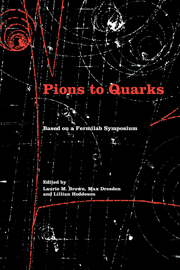Book contents
- Frontmatter
- Contents
- List of contributors
- Foreword by Leon M. Lederman
- Editors' acknowledgments
- Photographs of the symposium
- List of abbreviations
- List of notation
- I Introduction
- II Particle discoveries in cosmic rays
- III High-energy nuclear physics
- IV The new laboratory
- V The strange particles
- 19 The hydrogen bubble chamber and the strange resonances
- 20 A particular view of particle physics in the fifties
- 21 Strange particles
- 22 Strange particles: production by Cosmotron beams as observed in diffusion cloud chambers
- 23 From the 1940s into the 1950s
- VI Weak interactions
- VII Weak interactions and parity nonconservation
- VIII The particle physics community
- IX Theories of hadrons
- X Personal overviews
- Name index
- Subject index
22 - Strange particles: production by Cosmotron beams as observed in diffusion cloud chambers
Published online by Cambridge University Press: 07 May 2010
- Frontmatter
- Contents
- List of contributors
- Foreword by Leon M. Lederman
- Editors' acknowledgments
- Photographs of the symposium
- List of abbreviations
- List of notation
- I Introduction
- II Particle discoveries in cosmic rays
- III High-energy nuclear physics
- IV The new laboratory
- V The strange particles
- 19 The hydrogen bubble chamber and the strange resonances
- 20 A particular view of particle physics in the fifties
- 21 Strange particles
- 22 Strange particles: production by Cosmotron beams as observed in diffusion cloud chambers
- 23 From the 1940s into the 1950s
- VI Weak interactions
- VII Weak interactions and parity nonconservation
- VIII The particle physics community
- IX Theories of hadrons
- X Personal overviews
- Name index
- Subject index
Summary
The physicist's ability to study the properties of strange particles expanded greatly following the observation of machine-produced V particles. Protons were accelerated by the Cosmotron to 1 GeV in May 1952; however, by the time shielding was added and the target, beam, and detector equipment put in place, it was the spring of 1953. At this point, experimenters could begin to collect data. Among the first detectors to be used was the highpressure hydrogen diffusion cloud chamber with an 11,000-G magnetic field. In the first 4,000 photographs, with the chamber exposed to a high-energy neutron beam, several V particles popped up. Two of these had tracks that gave momentum and angle measurements of sufficient accuracy to be convincing. That led to the first studies exploiting the advantages the accelerator had over cosmic rays.
In the summer of 1950, several groups were experimenting with continuously sensitive diffusion cloud chambers, and Ralph P. Shutt recognized their potential use for Cosmotron experiments, in particular if high-pressure hydrogen could be made to work. Great enthusiasm and a wide variety of skills existed at that time in Shutt's cloud-chamber group, and very shortly two 20-atm hydrogen diffusion chambers had been constructed. Through the effort of Gilberto Bernardini this equipment was moved to the Nevis cyclotron, where exposures to pion beams demonstrated the usefulness of this new tool. With the addition of a new magnet, the high-pressure hydrogen diffusion chamber was on the floor of the Cosmotron when the first experiments began.
- Type
- Chapter
- Information
- Pions to QuarksParticle Physics in the 1950s, pp. 343 - 347Publisher: Cambridge University PressPrint publication year: 1989



